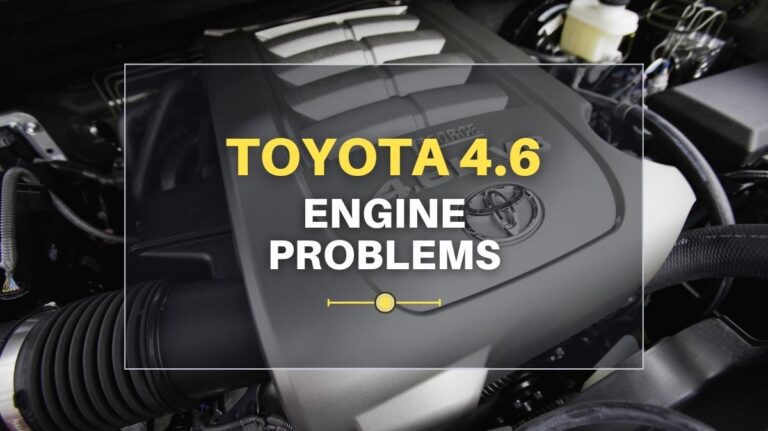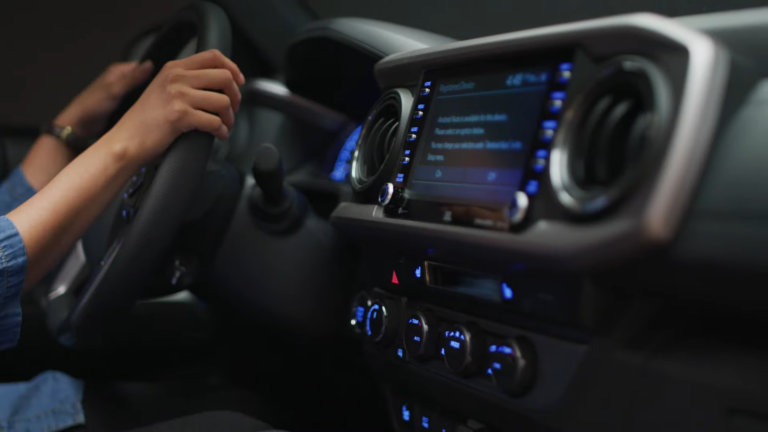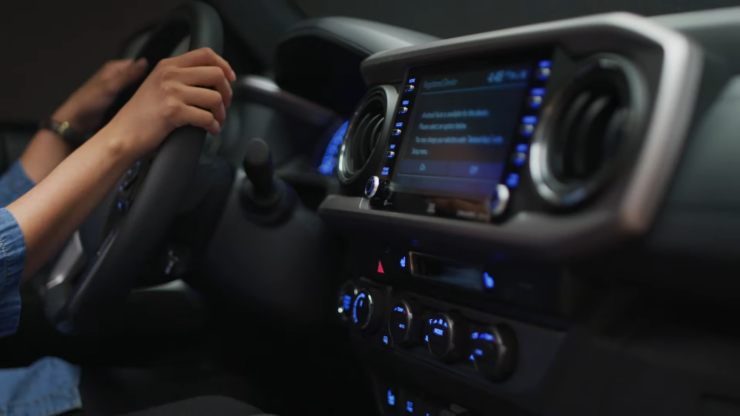In this article, we will be delving into the finer details of the Toyota 4.6 engine problems.
To continue progressing with the times, the Toyota Motor Corporation has developed the Toyota 4.6 Engine.
A newly developed upgrade from the UZ engines, the 1UR FE family is all of 4.6 L of durable aluminum alloy.
Most Toyota trucks and pickups now come with the 4.6 engine. Upgraded though it is, the Toyota 4.6 engine has its fair share of problems.
Toyota 4.6 Engine Details
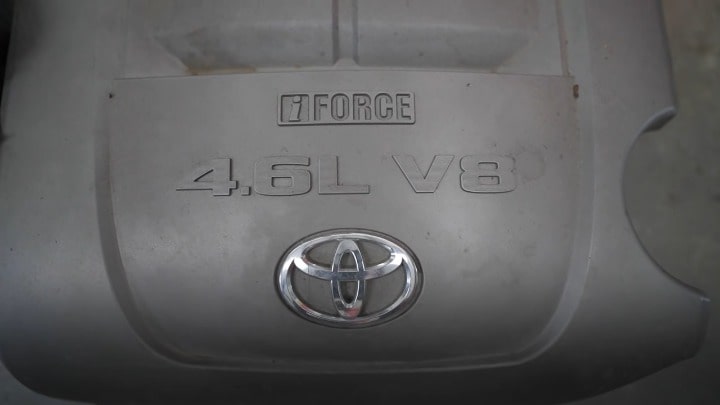
The Toyota 4.6 engine has been in production since 2006. As an engine designed for large trucks and vans, the 4.6 was expected to be a gas guzzler.
However, the manufacturers managed to limit the diesel the 4.6 engine uses without adversely affecting its power.
Anyone familiar with Toyota pick-ups like the Tundra knows that the 4.6 can’t handle too much luggage. So its hauling capabilities are not as impressive in the face of other Toyota-made engines like the 5.7.
Fortunately, the 4.6 makes up for it by being as smooth and quiet as a Lexus with striking fuel-saving properties. Not to mention, it comes with the reliability of the original 2UZ-FE engines, which were the predecessors to the 4.6.
As a V8 engine, the Toyota 4.6 engine has the requisite eight cylinders in the “V” formation.
The incredible thing is that these cylinders are made from a metal known for their durability and longevity- aluminum.
This is one of the more notable improvements present in the 1UR engines that the previous model lacked. The pistons are also made from aluminum. The cylinder has four oil jets for the sole purpose of using oil to keep the pistons cool.
The Toyota 4.6 engine is on a roll for its usage of solid metals as they crafted their spark plugs out of the highly long-lasting iridium metal.
The Toyota 4.6 engine crankshaft has six balance weights, two less than its forerunner. Due to the decrease in balance weights, the Toyota 4.6 engine runs noticeably less smoothly than the previous version.
While the cylinders maintain their typical V8 formation, the aluminum cylinder heads now come with two camshafts and four valves per cylinder.
Instead of timing belts, the 4.6 engine has timing chains. Timing chains propel the intake camshafts.
Said camshafts manage the exhaust camshafts through the usage of a secondary timing chain on each head.
The engine is equipped with Toyota’s Dual VVT-i system. In typical Toyota fashion, the system runs the camshafts, the Direct Ignition System (DIS), Acoustic Control Induction System (ACIS), and Electronic Throttle Control System – intelligent (ETCS-i).
The engine utilizes fuel injections. They are facilitated by the twelve-hole fuel injectors and done in the fashion of L-type fuel injections.
Features of Toyota 4.6 Engine
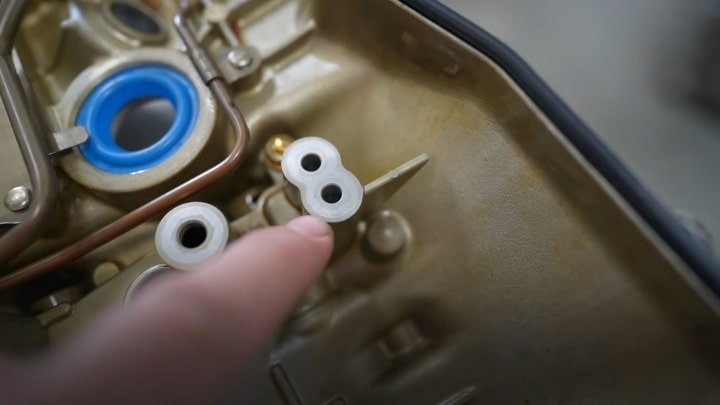
The Toyota 4.6l engine is the product of masterful engineering, ten steps ahead of the old 2UZ-FE engine. The 1UR (Toyota 4.6 engine) incorporates incredible injection technology with the tried-and-true Toyota dual VVT-i system and V8 formation.
Other features of the Toyota 4.6 engine include:
- Timing chains used instead of unreliable timing belts
- Fuel efficiency estimates of 15 mpg city and 20 mpg on the highway.
- Six-speed automatic transmission.
- Electronic Throttle Control System – intelligent (ETCS-i).
- Acoustic Control Induction System (ACIS)
- Direct Ignition System (DIS) included
- Aluminum alloy cylinder block with cast-iron liners.
- Aluminum alloy cylinder heads
- Separated camshaft housings
- Two camshafts for each cylinder bank
- Four valves per cylinder
- Durable iridium-tipped spark plugs
- L-type sequential fuel injection (SFI)
- Twelve-hole fuel injectors
- ULEV II emissions certification.
- Reduced stroke to 83.0 mm.
- Forged steel crankshaft.
- Six balance weights on crankshaft
- Torsional rubber damper.
- Resin-coated aluminum pistons.
- Forged connecting rods
- Four oil jets in the cylinder block
- Water-cooled Exhaust Gas Recirculation (EGR) system
- Roller rocker arms activate exhaust and intake valves
- Hydraulic lifters included with valvetrain
- Four-into-one (4-1) stainless steel headers in the exhaust system
- Stainless steel exhaust pipes
Specification of Toyota 4.6 Engine
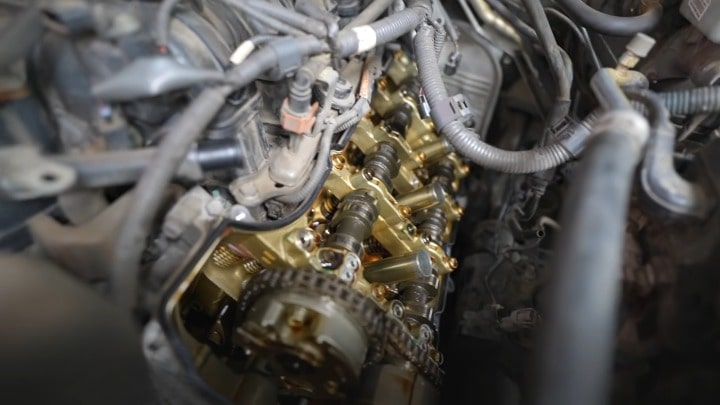
- Manufactured by Toyota Motor Corporation
- Production is from 2006 to present
- Runs on gasoline
- Fuel system: Fuel injection
- Cylinder block and the head is made from Aluminium
- Eight cylinders
- 4 Valves per Cylinder
- Naturally aspirated Four-stroke internal combustion engine
- Engine weighs 476 lbs (216 kg) – 1UR-FE, 511 lbs (232 kg) – 1UR-FSE
- Power, hp:
– 304 hp (227 kW)/5,500
– 347 hp (259 kW)/6,400
– 385 hp (287 kW)/6,400 – 1UR-FSE
- 5W-30 Engine oil weight
- Engine oil capacity, liter:
– 7.5 (7.9 qt)
– 0.4 (0.42 qt) – oil filter.
- 10,000 miles (15,000 km) / 12 months is the Oil change interval
- Compression Ratio:
– 10.2:1 – 1UR-FE
– 11.8:1 – 1UR-FSE
Computable Vehicles for 1UR engine
- Toyota Tundra
- Toyota Sequoia
- Toyota Land Cruiser
- Lexus LS 460
- Lexus GS 460
- Lexus GX 460
Common Toyota 4.6 Engine Problems and Solutions
01. Motor Knocking Problems
The kind of motor knocking we are referring to here is the type that occurs due to a failing piston and is more likely to happen in aluminum blocks. This sort of knocking occurs when the piston is being forced up and down the cylinder.
Generally, the piston does need to perform this up and down movement, but when the motion becomes involuntary, the piston begins rocking.
When pistons experience cold clearance, they gain more speed. Since they have a vast wall clearance, to begin with, more speed only results in the piston rocking. This is the knocking sound you may hear while the car is running or idling.
Solution for motor knocking
The most obvious solution is to replace the piston as well as the rings. You could do this at home. Just ensure that the engine loses compression before you attempt to replace the pistons. Note that piston replacement is a complicated procedure.
Of course, the safest and best bet is to take the car to a mechanic. The parts can cost anywhere from $30 to $150. The fix, however, is priced from $1500 to $2500.
02. Oil Consumption Problems
Excessive oil consumption happens when there is too much clearance between the valve stems and guides. The engine winds up taking in more oil down the guides and into the cylinders as a side effect of worn, broken, or poorly installed guide seals.
Excessive oil consumption is one of the problems shared by many major car manufacturers other than Toyota. Many such brands will say that the level at which the engine is consuming oil is perfectly normal.
They can elude responsibility because oil consumption is determined based on manufacturer standards. Japanese manufacturers like Toyota say a quart for every 1000 to 1200 miles is fine. However, some Toyota consumers experience up to 0.5 liters of consumption every 1000 miles.
Solution for oil consumption
In most cases, owners are advised to drive the vehicle for a minimum of 1000 miles and then return it to the manufacturer, where they run tests to determine if excessive oil consumption is present. From there, the manufacturers will take further action if the tests prove the buyer’s claim to be valid.
Sometimes manufacturers will credit a mechanic or repair shop to replace parts of the engine or completely rebuild the entire thing. Sadly, they will often blame lousy driving habits or say that the oil consumption levels are standard instead of repairing themselves.
There is no DIY solution here. Take the car to a mechanic and see the damage. It may be more feasible to buy a new vehicle entirely depending on the extent of engine repair that needs to be done.
03. Water Pump Leaks
Water Pump leaks reveal themselves through low coolant level or coolant leak in the front of the car, overheating and or a high-pitched whine or growl coming from the engine.
When faced with any of these symptoms, your water pump is likely leaking, as Toyota 4.6l engines are prone to do.
Adding a contaminated or just plain worn coolant to your system often results in a water pump leak. The leak can also be due to dry running when the system operates without any coolant.
In any case, if the vehicle comes like this, this is a manufacturer problem and can be sent back to Toyota under warranty.
Solution for water pump leak
The most probable solution is to replace the water pump. A few industrious persons may choose to replace the pump themselves. Just be sure to install a new cooling system thermostat and remember to flush said system while you’re at it.
Others can choose the safer but more expensive option to take the car to a mechanic to diagnose the problem correctly. The average cost of replacing a water pump is $642.
04. Joint Problems
It is unlikely that your new car came with worn joints. They are more than likely loose or bad. In any case, Toyota’s 4.6 engines suffer from joint problems.
Loose or worn ball joints produce low, clunking noises usually heard when the car turns the corner or goes over a bump. The steering wheel may become uncomfortably stiff or loose, and the tires begin to wear unevenly.
Solution for joint problems
Whether the joints are worn, rotten, or loose, you can easily replace ball joints at home or take the problem to a mechanic, where they can fix the problem for $160 to $200 for each joint.
05. Hydraulic Timing Chain Tensioner Problems
The timing chain is the part that makes all the other engine parts work together. It grabs onto the gears and wheels and transmits the movement of the crankshaft to the camshaft.
Due to a flaw in the design, Toyota 4.6 engines have issues with the hydraulic timing chain tensioner. It tends to loosen the timing chain, which can cause the engine to skip time or fail altogether.
It is usually caused by a lack of proper maintenance or regular oil changes. In Toyota’s case, some 4.6 engines were born that way.
That is, some consumers have noticed that the timing chain is already stretched upon arrival.
Solution for hydraulic timing chain
A timing chain gone bad will produce a rattle in the engine and or engine codes. The system may check the engine lights before any actual rattling happens.
You can try to replace the timing chain at home. Note that the sprockets will also have to be replaced.
At the mechanic, timing chain replacements can cost up to $958.
06. Thin Valve Spring Problems
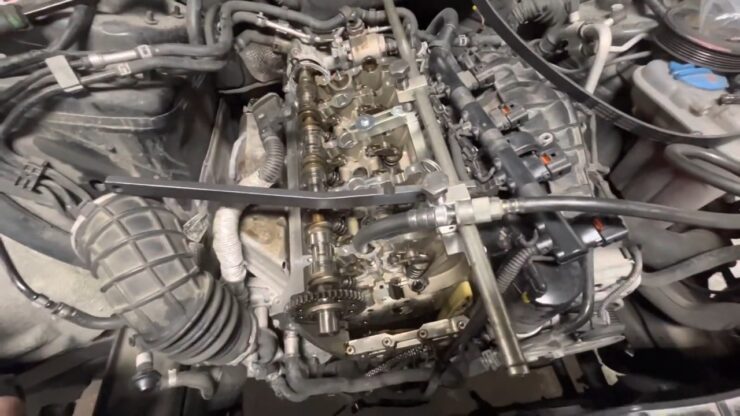
The thin valve springs are a common problem with other Toyota engines and not just the 4.6. The problem resides in the fact that these thin valve springs break after a short period. It often results in rough idling or the vehicle not starting at all.
Solution for valve spring problem
This is a very costly fix and not one to be undertaken by novices. It can cost up to $2150 to fix said issue depending on if any other components were damaged, like the cylinder block and head.
Toyota acknowledged the seriousness of this problem as they had recalled several vehicles with the 4.6l engine to address the matter.
07. Transmission Failures
The transmission goes bad when its parts have been internally worn down, torn, contaminated, intruded by water, or it has low transmission fluids.
When the engine becomes high revving, the most likely cause is that the transmission is going or has already gone bad.
Solution for transmission failure
Many Toyota owners report hesitation when shifting gears in their automatic transmission 4.6l engine. If one can diagnose the exact cause of transmission failure in their vehicles, it can be fixed at home.
At the lower end of the spectrum, there is a $150 charge for just replacing the transmission fluids, which can be done cost-free (at least for the labor, the parts fluids and equipment will still cost you) at home.
In the same breath, mechanics charge up to $3500 to replace faulty transmissions.
FAQs
Does the Toyota 4.6 engine have a timing belt?
No, the Toyota 4.6 engine does not have a timing belt. It has a timing chain instead, which is designed to last the lifetime of the engine and does not require regular replacement like a timing belt. However, it is still important to follow the manufacturer’s recommended maintenance schedule for the engine to ensure optimal performance and longevity.
What is the best Toyota V8 engine?
Determining the “best” Toyota V8 engine depends on several factors, including intended use, personal preference, and performance needs. However, there are a few Toyota V8 engines that are particularly noteworthy for their reliability, power, and versatility.
One of the most popular Toyota V8 engines is the 5.7-liter V8 found in the Toyota Tundra and Toyota Sequoia. This engine is known for its impressive towing capacity, smooth power delivery, and reliability.
Another popular Toyota V8 engine is the 4.7-liter V8, which was used in several Toyota models including the Tundra, Sequoia, and Land Cruiser. This engine is known for its durability and low-end torque, making it well-suited for off-road and towing applications.
The Lexus 1UR-FSE 5.0-liter V8 is also a highly-regarded Toyota V8 engine, known for its smooth power delivery, efficiency, and reliability. This engine is used in several Lexus models, including the LS, GS, and IS.
How long does a 4.6 engine last?
The lifespan of a 4.6 engine can vary depending on several factors such as maintenance, driving conditions, and usage. With proper maintenance and care, a 4.6 engine can last up to 200,000 to 300,000 miles or more.
However, if the engine is not maintained properly or is subjected to harsh driving conditions, its lifespan can be significantly reduced. It’s important to regularly change the oil, air filter, and other fluids as recommended by the manufacturer to ensure the longevity of the engine.
How many miles does a Toyota 4.6 engine do?
The lifespan of a Toyota 4.6 engine can vary depending on various factors such as maintenance, driving habits, and environmental conditions. However, with proper maintenance and care, a Toyota 4.6 engine can last for over 200,000 miles or more.
Many Toyota owners report their 4.6 engines lasting up to 300,000 miles or more with regular maintenance and occasional repairs. It’s important to follow the recommended maintenance schedule and have any issues addressed promptly to ensure the longevity of the engine.
Will Toyota discontinue its V8 engines?
It has been reported that Toyota plans to phase out V8 engines from its lineup in the near future, as the company shifts its focus towards hybrid and electric powertrains. However, it is not clear if this means that all V8 engines will be discontinued, or if certain models will still offer V8 options.
The company has not provided an official statement on the matter, so it remains to be seen how the future of Toyota’s V8 engines will unfold.
Reliability of Toyota 4.6 Engine
Though an update from the previous 2UZ-FE engines, the Toyota 4.6 engine seems to share old problems with its predecessor.
Issues like water pump leaks, joint issues, thin valves, increased oil consumption, and a failing hydraulic chain tensioner did not change in this new upgrade.
Another engine in this line is the 5.7 engine with similar, if not identical, features to the Toyota 4.6 engine. In a side-by-side comparison, the 4.6 engine falls short in terms of power and mileage.
Verdict
The Toyota 4.6 engine has numerous problems but overall is a reliable engine for most. Its problems are not so overwhelming as to detract from its unique features and durability.
Keep in mind that these potential issues are not a must. Some Toyota owners have gone the majority, or sometimes entirety, of their own without a glimpse of even one of these problems.

